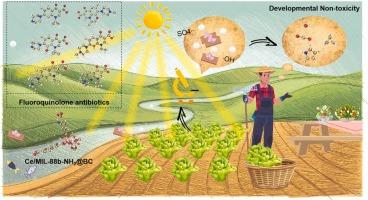DFT-guided design of biochar-based composites for photocatalytic degradation of fluoroquinolone antibiotics in soil-water systems: Non-targeted metabolomics and structural equation modeling
IF 11.3
1区 环境科学与生态学
Q1 ENGINEERING, ENVIRONMENTAL
引用次数: 0
Abstract
The accumulation of fluoroquinolone antibiotics (FQs) in soil-plant systems causes ecotoxicity. Traditional photocatalysts have high electron-hole recombination and unknown degradation product toxicity, making multi-media treatment difficult. This study used DFT-guided Ce/MIL-88b-NH2@BC composites to elucidate FQs’ degradation mechanism of six FQs and assessed the effects of the composite on plant metabolism and system repair. By integrating non-targeted metabolomics and structural equation models, the "material-contaminant-plant" interaction network was analyzed. Ce/MIL-88b-NH2@BC achieved a 98.9 % FQs degradation rate in 90 min under UV–Vis light, dropping slightly to 82.5 % under sunlight. SO4·- and ·OH were the key radicals driving degradation pathways, such as piperazine ring rupture and decarboxylation, converting the parent FQs into low-toxicity substances. The content of FQs in lettuce leaves was less than or equal to 1 ng g⁻1, well below the planetary boundary (PB) of 153.7 μg kg⁻¹ of antibiotic concentrations in agricultural soils worldwide. Ce/MIL-88b-NH2@BC reduced plant toxicity by degrading pollutants, inhibiting overactivated stress pathways, restoring normal physiology, and shifting resources to growth-related metabolism. Structural equation models were used to quantify the relationships between key metabolites and plant physiological indices. The whole chain strategy of "computational design-experimental validation-system modeling" is pioneered in this study to provide a predictable intelligent solution for antibiotic pollution control.

生物炭基复合材料在土壤-水系统中光催化降解氟喹诺酮类抗生素的dft指导设计:非靶向代谢组学和结构方程建模
氟喹诺酮类抗生素(FQs)在土壤-植物系统中的积累引起生态毒性。传统光催化剂的电子空穴复合率高,降解产物毒性未知,给多媒体处理带来困难。本研究利用dft引导的Ce/MIL-88b-NH2@BC复合材料阐明了6种FQs的降解机制,并评估了复合材料对植物代谢和系统修复的影响。通过整合非靶向代谢组学和结构方程模型,分析了“物质-污染物-植物”相互作用网络。Ce/MIL-88b-NH2@BC在UV-Vis光下90 min的FQs降解率达到98.9%,在日光下略微下降到82.5%。SO4·-和·OH是驱动哌嗪环破裂和脱羧等降解途径的关键自由基,将母体FQs转化为低毒物质。莴苣叶中FQs的含量小于或等于1微克- 1,远低于全球农业土壤中抗生素浓度153.7微克- 1的行星边界(PB)。Ce/MIL-88b-NH2@BC通过降解污染物、抑制过度激活的应激途径、恢复正常生理和将资源转移到生长相关代谢来降低植物毒性。采用结构方程模型量化关键代谢物与植物生理指标之间的关系。本研究首创“计算设计-实验验证-系统建模”的全链条策略,为抗生素污染控制提供可预测的智能解决方案。
本文章由计算机程序翻译,如有差异,请以英文原文为准。
求助全文
约1分钟内获得全文
求助全文
来源期刊

Journal of Hazardous Materials
工程技术-工程:环境
CiteScore
25.40
自引率
5.90%
发文量
3059
审稿时长
58 days
期刊介绍:
The Journal of Hazardous Materials serves as a global platform for promoting cutting-edge research in the field of Environmental Science and Engineering. Our publication features a wide range of articles, including full-length research papers, review articles, and perspectives, with the aim of enhancing our understanding of the dangers and risks associated with various materials concerning public health and the environment. It is important to note that the term "environmental contaminants" refers specifically to substances that pose hazardous effects through contamination, while excluding those that do not have such impacts on the environment or human health. Moreover, we emphasize the distinction between wastes and hazardous materials in order to provide further clarity on the scope of the journal. We have a keen interest in exploring specific compounds and microbial agents that have adverse effects on the environment.
 求助内容:
求助内容: 应助结果提醒方式:
应助结果提醒方式:


